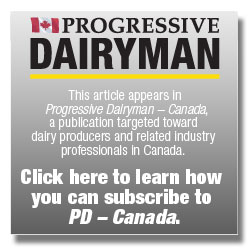There are several ways to get heifers bred quickly after they move into the breeding pen. “Walk and chalk” is the strategy of choice for Vance Kells, owner of Circle Bar Heifer Ranch in Satanta, Kansas.
Kells says Circle Bar personnel walk through the breeding pen daily for 10 days, tail-chalking heifers and breeding those observed in heat. On Day 11, they administer prostaglandin to any heifers not yet bred.

This heat-detection strategy has been in place for the last couple of years, Kells says. “It fits our time frame the best,” he adds.
It also has proven quite successful – 98 to 99 percent of all heifers are bred within the first 17 days of being in the breeding pen. These results mesh with the breeding goals outlined in DCHA’s Gold Standards II, which state that 80 percent of heifers should be inseminated within the first 21 days of moving to the breeding pen.
Circle Bar also has used various estrus synchronization protocols, with or without progesterone-releasing (CIDR) inserts, and timed-A.I. to manage heifer reproduction. All of them have worked well, Kells says.
The approach you choose depends on how aggressive you want your A.I. program to be and how much help your heifers need, he says.
Use good A.I. practices
Kells says one of the biggest mistakes in breeding heifers is the mishandling of semen.
Fortunately, the list of good management practices to use during insemination keeps growing.
Research reported last year by Ohio State University researchers showed a reduction in equipment contamination when inseminators used a double-plastic sheath during A.I.
The field trial included 2,220 lactating Holstein cows from three commercial herds. Cows were enrolled in a Presynch/Ovsynch or Presynch/Cosynch program. At the time of A.I., technicians either covered or did not cover the A.I. sheath with a disposable sheath protector.
Following breeding, researchers cultured swab samples from the A.I. catheter to determine the level of bacterial contamination. They concluded that the use of a disposable sheath protector reduced contamination of the A.I. catheter (51.9 percent contamination in the double-sheath group vs. 98 percent in the control group.)
Use of a double-plastic sheath also improved pregnancies per A.I. in the treatment group to 30.1 percent versus 25.4 percent in the control group.
Although this study involved lactating cows, the cleanliness of A.I. procedures and equipment should not be compromised in heifers either.
Nutrition and ovulation
Nutrition plays an important role in the reproductive performance of heifers, too.
Israeli research reported in 2011 in the Journal of Dairy Science examined the effect of high dietary crude protein on characteristics of preovulatory follicles in Holstein heifers.
Treatments consisted of a low (6 percent), moderate (13 percent) or high (20 percent) crude protein diet. Diets were formulated to contain approximately 66 percent wheat straw and various proportions of ground corn and soybean meal.
The researchers synchronized the estrous cycles of the heifers and administered prostaglandin 14 days after behavioral estrus. On day 39 of each period, they collected follicular fluid from follicles with a diameter greater than 7 mm.
The high-protein diet increased urea concentrations in preovulatory follicular fluid. Heifers fed the high-protein diet had greater estradiol and progesterone concentrations in follicular fluid than heifers fed the moderate-protein diet.
However, there were no differences in estrogen- to-progesterone ratios between diets. There also were no differences in follicle diameter between the three treatments.
The researchers concluded that high levels of dietary crude protein caused increased concentrations of urea in preovulatory follicles, but this did not have a detrimental effect on the follicles. They contend that heifers possess “fewer nutritional and physiological constraints” than lactating cows, which may help offset a negative reproductive response when high protein levels are fed.
Although this study showed no harm in feeding high levels of crude protein, DCHA’s Gold Standards II encourage a more moderate crude protein content of 13.5 to 14 percent for breeding-age and older heifers.
Breeding goals for Holstein heifers
Good reproductive management is an important aspect of heifer rearing. Regularly assess your heifer reproductive program. Compare where your operation is against the following Gold Standards breeding guidelines for Holstein heifers:
- Begin breeding at 13 to 15 months old. Strive for a weight of 825 to 900 pounds, hip height greater than 50 inches and wither height of 48 inches (or breed when heifers reach 55 percent of the weight of mature cows in the herd.)
- Inseminate at least 80 percent of heifers within the first 21 days of moving them into the breeding pen.
- Achieve greater than 70 percent first-service conception rate with conventional semen and 7 to 12 percent less with sexed semen.
- Strive to have 85 percent of heifers pregnant after three heat cycles.
- Freshen heifers at 22 to 24 months old.
To learn more about Circle Bar Heifer Ranch LLC, click here to visit the DCHA website, then click on the News Tab and under Featured Videos, you’ll find a link to the virtual tour that was presented at DCHA’s recent Dairy Calf & Heifer Conference. Note: “A Look at Circle Bar Heifer Ranch LLC” virtual tour was underwritten by Pfizer Animal Health. PD
The Dairy Calf & Heifer Association is a national association dedicated to serving the dairy calf and heifer industry. DCHA strives to provide information, education and access to leading research and technology to help its members be more profitable.
For more information about DCHA and the Gold Standards, click here or call 877-HEIFERS.
PHOTO 1:Good reproductive management is an important aspect of heifer rearing. Regularly assess your heifer reproductive program.Courtesy photo from DCHA.
PHOTO 2:Good reproductive management is an important aspect of heifer rearing. Regularly assess your heifer reproductive program.






